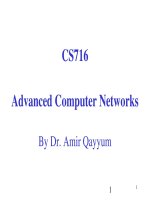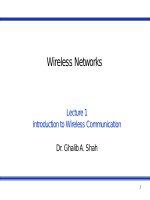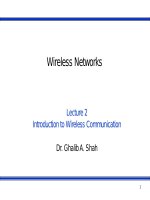Wireless networks - Lecture 36: Routing in WSN
Bạn đang xem bản rút gọn của tài liệu. Xem và tải ngay bản đầy đủ của tài liệu tại đây (599.06 KB, 34 trang )
Wireless Networks
Lecture 36
Routing in WSN Part III
Dr. Ghalib A. Shah
1
Outlines
Routing Challenges and Design Issues
► Deployment, Routing method, heterogeneity, fault tolerance,
power, mobility etc
Routing Protocols
►
►
►
►
►
►
►
►
SPIN
Directed Diffusion
ACQUIRE
LEACH
TEEN/APTEEN
GAF
GEAR
SPEED
2
Last Lecture
Challenges in WSNs.
Attributes of MAC Protocol
Overview of MAC protocols
Energy Efficiency in MAC
Proposed Routing Protocol
►
►
►
►
►
►
S-MAC
T-MAC
DS-MAC
Traffic Adaptive MAC
DMAC
Contention-Free MAC
3
Routing challenges and design issues
Node deployment
► Manual deployment
• Sensors are manually deployed
• Data is routed through predetermined path
► Random deployment
• Optimal clustering is necessary to allow connectivity &
energy-efficiency
• Multi-hop routing
4
Routing challenges and design issues
Data routing methods
►
►
►
►
►
Application-specific
Time-driven: Periodic monitoring
Event-driven: Respond to sudden changes
Query-driven: Respond to queries
Hybrid
5
Routing challenges and design issues
Node/link heterogeneity
► Homogeneous sensors
► Heterogeneous nodes with different roles &
capabilities
• Diverse modalities
• If cluster heads may have more energy & computational
capability, they take care of transmissions to the base
station (BS)
Fault tolerance
► Some sensors may fail due to lack of power,
physical damage, or environmental interference
► Adjust transmission power, change sensing rate,
reroute packets through regions with more power
6
Routing challenges and design issues
Network dynamics
► Mobile nodes
► Mobile events, e.g., target tracking
► If WSN is to sense a fixed event, networks can work
in a reactive manner
•
A lot of applications require periodic reporting
Transmission media
► Wireless channel
► Limited bandwidth: 1 – 100Kbps
► MAC
• Contention-free, e.g., TDMA or CDMA
• Contention-based, e.g., CSMA, MACA, or 802.11
7
Routing challenges and design issues
Connectivity
► High density high connectivity
► Some sensors may die after consuming their battery power
► Connectivity depends on possibly random deployment
Coverage
► An individual sensor’s view is limited
► Area coverage is an important design factor
Data aggregation
Quality of Service
► Bounded delay
► Energy efficiency for longer network lifetime
8
Routing Protocols in WSNs
I. Flat
II. Hierarchical
III. Location-based
IV. QoS-based
9
Flooding
► Too much waste
► Implosion & Overlap
► Use in a limited
scope, if necessary
Data-centric routing
► No globally unique ID
► Naming based on
data attributes
► SPIN, Directed
diffusion, ...
10
SPIN (Sensor Protocols for Information via
Negotiation)
11
SPIN
Pros
► Each node only needs to know its one-hop neighbors
► Significantly reduce energy consumption compared to flooding
Cons
► Data advertisement cannot guarantee the delivery of data
•
•
If the node interested in the data are far from the source, data will
not be delivered
Not good for applications requiring reliable data delivery, e.g.,
intrusion detection
12
Direct Diffusion: Motivation
Properties of Sensor Networks
►
►
►
►
►
►
Data centric
No central authority
Resource constrained
Nodes are tied to physical locations
Nodes may not know the topology
Nodes are generally stationary
How can we get data from the sensors?
13
Elements of Directed Diffusion
Naming
► Data is named using attributevalue pairs
Interests
► A node requests data by sending interests for named data
Gradients
► Gradients is set up within the network designed to “draw” events, i.e. data
matching the interest.
Reinforcement
► Sink reinforces particular neighbors to draw higher quality ( higher data rate)
events
14
Naming
Content based naming
► Tasks are named by a list of attribute – value pairs
► Task description specifies an interest for data matching the attributes
► Animal tracking:
Request
Interest ( Task ) Description
Type = fourlegged animal
Interval = 20 ms
Duration = 1 minute
Location = [100, 100; 200, 400]
Reply
Node data
Type =fourlegged animal
Instance = elephant
Location = [125, 220]
Confidence = 0.85
Time = 02:10:35
15
Interest
The sink periodically broadcasts interest messages to each of its neighbors
Every node maintains an interest cache
► Each item corresponds to a distinct interest
► No information about the sink
► Interest aggregation : identical type, completely overlap rectangle attributes
Each entry in the cache has several fields
► Timestamp: last received matching interest
► Several gradients: data rate, duration, direction
16
Setting Up Gradient
Source
ghbor’s choices :
Flooding
Geographic routing
Cache data to direct interests
Sink
Interest = Interrogation
Gradient = Who is interested
(data rate , duration, direction)
17
Data Propagation
Sensor node computes the highest requested event rate among all
its outgoing gradients
When a node receives a data:
► Find a matching interest entry in its cache
• Examine the gradient list, send out data by rate
► Cache keeps track of recent seen data items (loop prevention)
► Data message is unicast individually to the relevant neighbors
18
Reinforcing the Best Path
Source
The neighbor reinforces a path:
. At least one neighbor
. Choose the one from whom
t first received the latest event (low delay)
. Choose all neighbors from which
ew events were recently received
Low rate event
Sink
Reinforcement = Increased interest
19
Directed Diffusion: Pros & Cons
Different from SPIN in terms of on-demand data
querying mechanism
► Sink floods interests only if necessary
•
A lot of energy savings
► In SPIN, sensors advertise the availability of data
Pros
► Data centric: All communications are neighbor to neighbor with
no need for a node addressing mechanism
► Each node can do aggregation & caching
Cons
► On-demand, query-driven: Inappropriate for applications
requiring continuous data delivery, e.g., environmental
monitoring
► Attribute-based naming scheme is application dependent
•
•
For each application it should be defined a priori
Extra processing overhead at sensor nodes
20
ACQUIRE
View a WSN as a distributed DB
Complex queries can be divided into subqueries
BS sends a query
Each node tries to answer the query by using precached info and forwards the
query to another node
If the cached info is not fresh, the nodes gather info from their neighbors within a
lookahead of d hops
Once the query is resolved completely, it is sent back to BS via the reverse path or
shortest path
ACQUIRE can deal with complex queries by allowing many nodes send to send
responses
►
►
►
►
►
Directed diffusion cannot handle complex queries due to too much flooding
ACQUIRE can adjust d for efficient query processing
If d = network diameter, ACQUIRE becomes similar to flooding
In contrast, a query has to travel more if d is too small
Provides mathematical modeling to find an optimal value of d for a grid of sensors, but no
experiments performed
21
LEACH (Low Energy Clustering Hierarchy)
Cluster-based protocol
Each node randomly decides to become a cluster heads (CH)
CH chooses the code to be used in its cluster
►
CDMA between clusters
CH broadcasts Adv; Each node decides to which cluster it belongs based
on the received signal strength of Adv
CH creates a txmission schedule for TDMA in the cluster
Nodes can sleep when its not their turn to txmit
CH compresses data received from the nodes in the cluster and sends the
aggregated data to BS
CH is rotated randomly
22
LEACH
► Pros
•
•
Distributed, no global knowledge required
Energy saving due to aggregation by CHs
► Shortcomings
•
•
LEACH assumes all nodes can transmit with enough power to
reach BS if necessary (e.g., elected as CHs)
Each node should support both TDMA & CDMA
► Extension of LEACH [5]
•
•
High level negotiation, similar to SPIN
Only data providing new info is transmitted to BS
23
TEEN (Threshold sensitive Energy Efficient
Network protocol)
Reactive, event-driven protocol for time-critical applications
►
►
A node senses the environment continuously, but turns radio on and
xmit only if the sensor value changes drastically
No periodic xmission
•
•
CH sends its members a hard & a soft threshold
►
►
►
Don’t wait until the next period to xmit critical data
Save energy if data is not critical
Hard threshold: A member only sends data to CH only if data values
are in the range of interest
Soft threshold: A member only sends data if its value changes by at
least the soft threshold
Every node in a cluster takes turns to become the CH for a time
interval called cluster period
Hierarchical clustering
24
Multi-level hierarchical clustering in TEEN &
APTEEN
25









